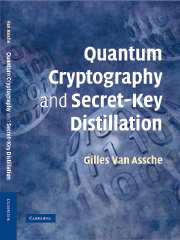Bondy, A.; Fonlupt, J.; Fouquet, J.-L.; Fournier, J.-C.; Ramirez Alfonsin, J.L. (Eds.)
Graph Theory in Paris
Proceedings of a Conference in Memory of Claude Berge
 Series: Trends in Mathematics
Series: Trends in Mathematics
2006, Approx. 400 p., Hardcover
ISBN: 3-7643-7228-1
Due: July 2006
About this book
In July 2004, a conference on graph theory was held in Paris in
memory of Claude Berge, one of the pioneers of the field. The
event brought together many prominent specialists on topics, such
as perfect graphs and matching theory, upon which Claude Berge's
work has had a major impact. This volume includes contributions
to these and other topics from many of the participants.
Written for:
Postgraduates and researchers in graph theory
Keywords:
Berge, Claude
Graphentheorie
Table of contents
Preface.- Research articles.
Gilles Van Assche
Quantum Cryptography and Secret-Key Distillation
 Hardback (ISBN-13: 9780521864855 | ISBN-10: 0521864852)
Hardback (ISBN-13: 9780521864855 | ISBN-10: 0521864852)
July 2006
Quantum cryptography (or quantum key distribution) is a state-of-the-art
technique that exploits properties of quantum mechanics to
guarantee the secure exchange of secret keys. This self-contained
text introduces the principles and techniques of quantum
cryptography, setting it in the wider context of cryptography and
security, with specific focus on secret-key distillation. The
book starts with an overview chapter, progressing to classical
cryptography, information theory (classical and quantum), and
applications of quantum cryptography. The discussion moves to
secret-key distillation, privacy amplification and reconciliation
techniques, concluding with the security principles of quantum
cryptography. The author explains the physical implementation and
security of these systems, enabling engineers to gauge the
suitability of quantum cryptography for securing transmission in
their particular application. With its blend of fundamental
theory, implementation techniques, and details of recent
protocols, this book will be of interest to graduate students,
researchers, and practitioners in electrical engineering,
physics, and computer science.
* The author provides extensive coverage of secret-key
distillation techniques, which is covered in less detail in other
literature
* This self-contained and multi-disciplinary book brings together
the physical aspects of the process with information and coding
theory
* The book not only addresses the theory of quantum cryptography
but also the practical issues of physical implementation
Contents
1. Introduction; 2. Classical cryptography; 3. Information
theory; 4. Quantum information theory; 5. Cryptosystems based on
quantum key distribution; 6. General results on secret-key
distillation; 7. Privacy amplification using hash functions; 8.
Reconciliation; 9. Non-binary reconciliation; 10. The BB84
protocol; 11. Protocols with continuous variables; 12. Security
analysis of quantum key distribution; Appendix 1. Symbols and
abbreviations.
Lokenath Debnath / University of Texas- Pan Am, Edinburg, Texas, USA
Integral Transforms and Their Applications
 ISBN: 1584885750
ISBN: 1584885750
Publication Date: 7/3/1995
Number of Pages: 480
" Comprehensive coverage of integral transforms and their
applications
Over 750 worked examples, exercises, and applications
Ready-to-use tables of integral transforms
Concise discussions of special functions, including gamma, beta,
error, Bessel and Airy functions and their properties
Helpful figures and diagrams used to illustrate and clarify
difficult concepts
Integral Transforms and Their Applications, provides a systematic
, comprehensive review of the properties of integral transforms
and their applications to the solution of boundary and initial
value problems. Over 750 worked examples, exercises, and
applications illustrate how transform methods can be used to
solve problems in applied mathematics, mathematical physics, and
engineering. The specific applications discussed include problems
in differential, integral, and difference equations; electric
circuits and networks; vibrations and wave propagation; heat
conduction; fractional derivatives and fractional integrals;
dynamical systems; signal processing; quantum mechanics;
atmosphere and ocean dynamics; physical chemistry; mathematical
biology; and probability and statistics.
Integral Transforms and Their Applications includes broad
coverage the standard material on integral transforms and their
applications, along with modern applications and examples of
transform methods. It is both an ideal textbook for students and
a sound reference for professionals interested in advanced study
and research in the field.
Contents
John N.S. Matthews / The University of Newcastle, Newcastle upon Tyne, UK
Introduction to Randomized Controlled Clinical Trials, Second
Edition
 Series: Texts in Statistical Science Series Volume: 68
Series: Texts in Statistical Science Series Volume: 68
ISBN: 1584886242
Publication Date: 6/27/2006
Number of Pages: 280
Provides a concise and accessible introduction to statistical
methods in clinical trials
Contains new and updated references, examples, exercises, and
material on binary outcomes and survival analysis
Includes numerous real examples from The Lancet
Features exercises at the end of each chapter with a solutions
appendix
Uses Minitab and R software throughout the text and in the
exercises
Focusing on the important role that statistical methods play in
the analysis of the data collected as well as in the overall
clinical trial process, Introduction to Randomized Controlled
Clinical Trials provides a concise and accessible introduction to
clinical trials. This second edition features new and updated
references, examples, exercises, and material on binary outcomes
and survival analysis. It features numerous real examples taken
from The Lancet, includes exercises at the end of the chapter,
and offers solutions in an appendix. Ideal for advanced
undergraduate and graduate students, the author uses Minitab and
R software throughout the text for implementing the methods
presented.
 Series: Trends in Mathematics
Series: Trends in Mathematics  Hardback (ISBN-13: 9780521864855 | ISBN-10: 0521864852)
Hardback (ISBN-13: 9780521864855 | ISBN-10: 0521864852) ISBN: 1584885750
ISBN: 1584885750 Series: Texts in Statistical Science Series Volume: 68
Series: Texts in Statistical Science Series Volume: 68